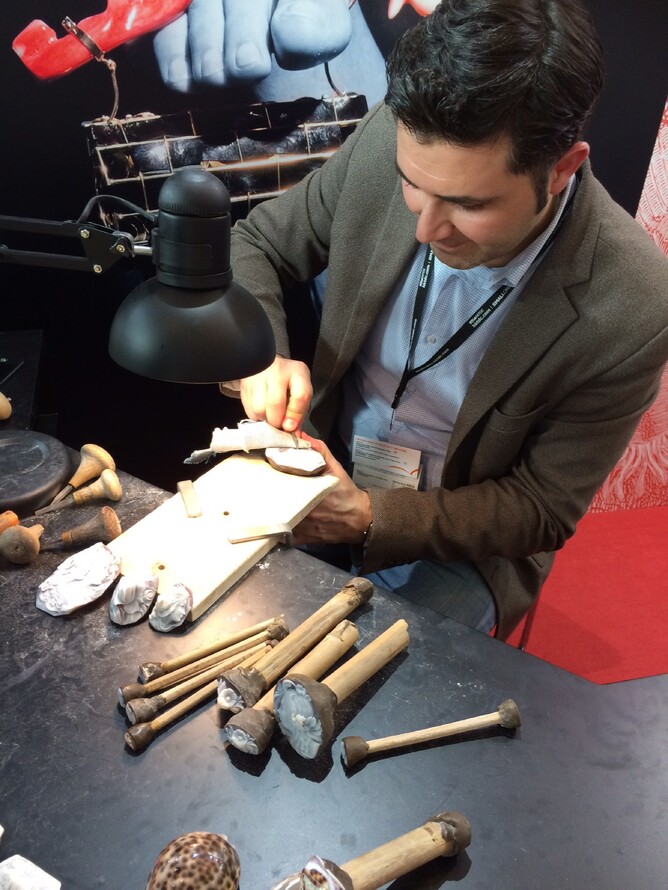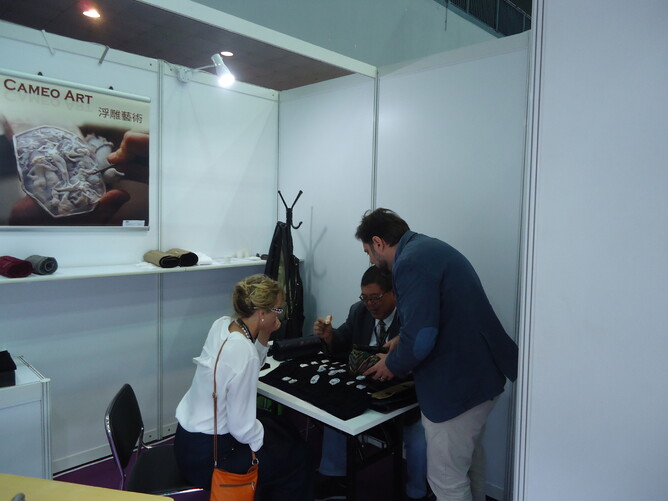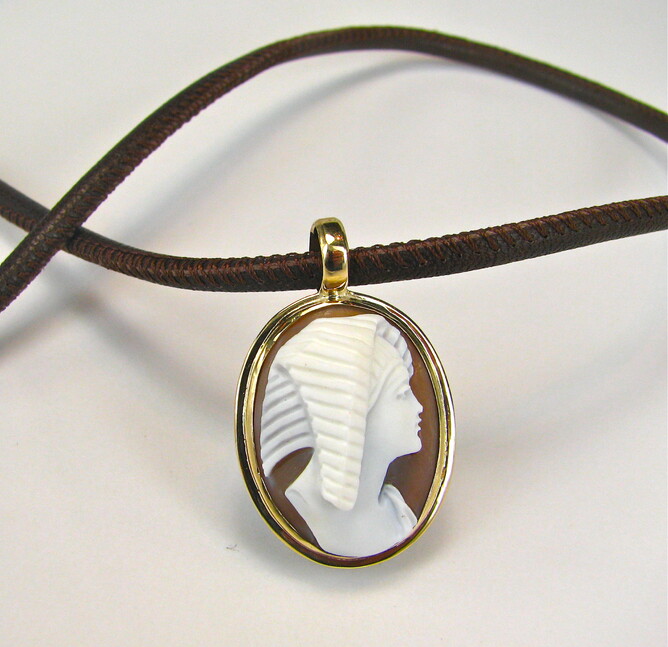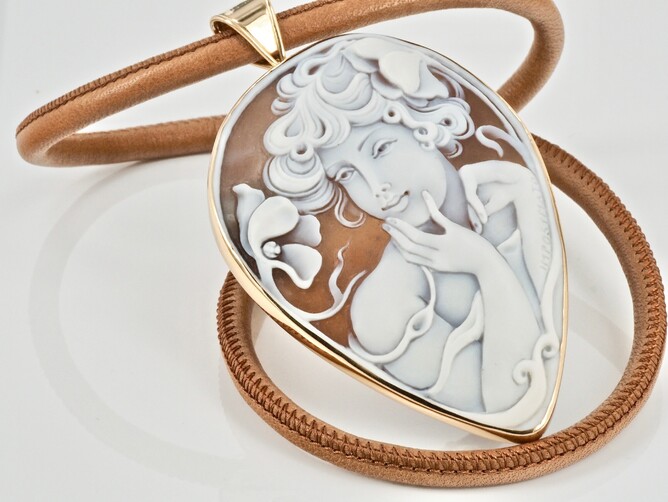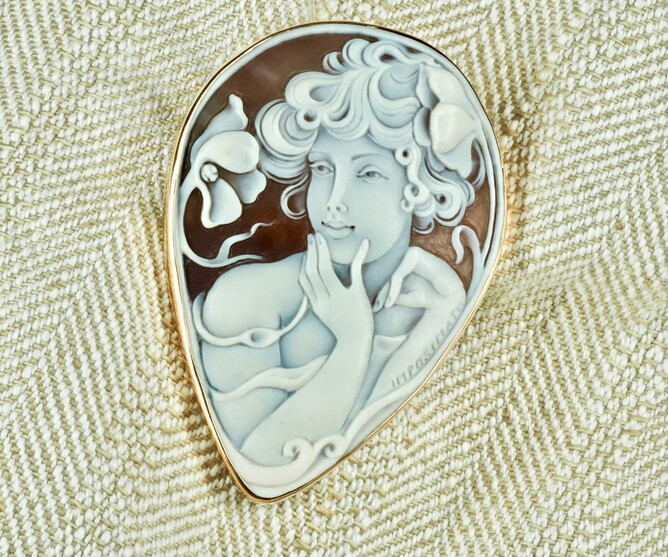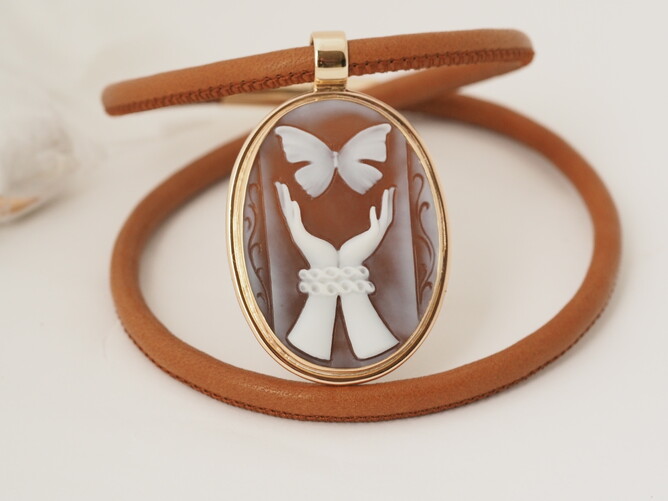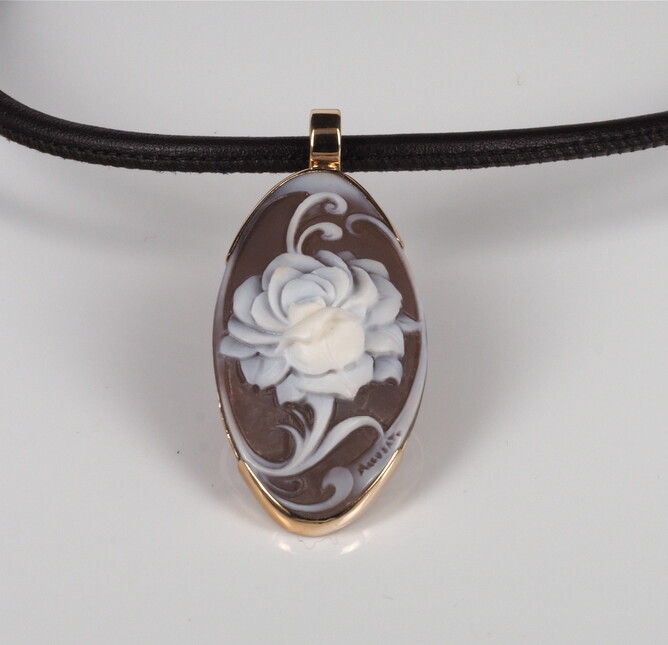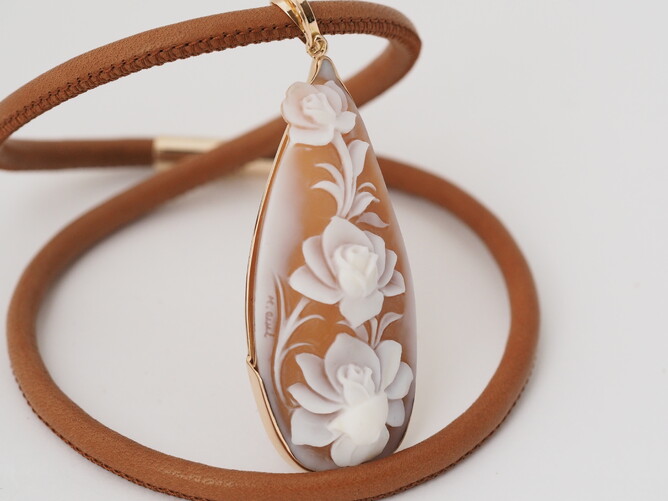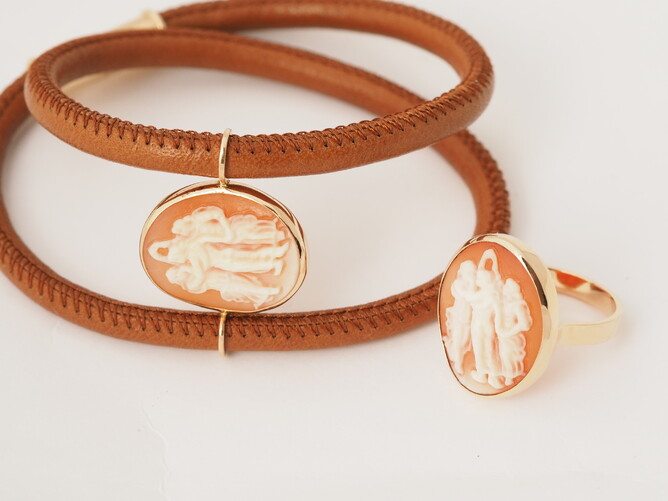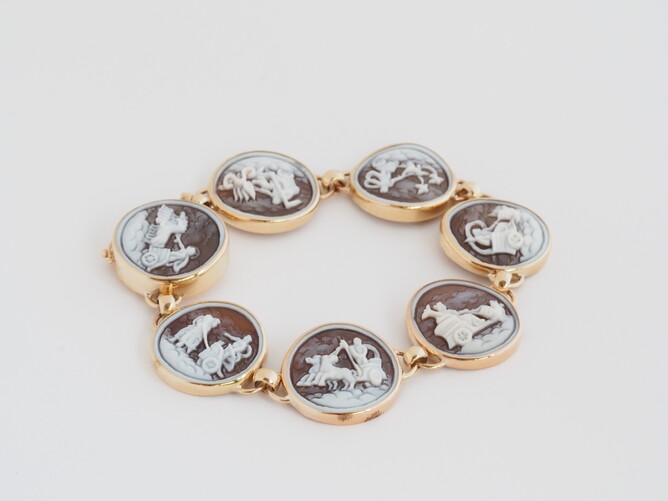Did someone say, 'Cameo'?
When the word cameo is mentioned, many people conjure up an image of their grandmother or an older lady wearing one in the form of a brooch, the cameo usually being the side profile of a pretty woman, with soft ringlet hair and frequently set in a surround of ornate yellow gold.
If people have this image in mind, it is perhaps harder to encourage them to view cameos in a different light and to see that they can have a place in today’s jewellery wardrobe.
What does the word 'cameo' mean?
The word cameo (pronounced, with an Italian accent, carr-meo) is from uncertain origins and means bas-relief, made by engraving a design on the top layer of materials such as marble, semi-precious stones, coral and shells, to leave a raised picture.
An intaglio on the other hand, is engraving 'into' semi-precious stone to create a negative picture.
History....? Yes, of course there is!
Finding good history on cameos has been much harder to come by, unlike my favourite topic of Pearls, where there are countless books on the subject.
The history I am interested in sharing with you is when cameo carving started and how it transitioned to shells.
Unfortunately, a lot of the history I have found on cameos is more about the subject matter than the development of the craft itself. It would be fair to say I did not find this at all riveting and in the words of Yoda from the latest Star Wars movie…. “page turners they were not.”
A touch of background.....
Cameo work is believed to have been around as far back as 3rd century BC and it is tied in with the time the Romans were making beautiful glass vessels.
After the fall of Alexander The Great, the Romans inherited the Hellenistic skills of making luxury glass vessels.
Like a good apprentice, they took the skills to another level and discovered that glass could be blown.
The Romans were considered ‘the most accomplished glass makers of the ancient world.’
The skill of glass blowing took hold in various parts of Italy. The beautiful vessels were costly, and could only be afforded by those with financial means. They were considered favourable to drink from or to hold liquids in as they lacked the smell that metal containers had.
Glass vessels that were made in moulds could be made with layers of glass, thus allowing bas-relief engraving.
A famous Roman vessel with cameo work on it, is ‘The Portland Vase’(click on here to view the vase)
The methods the craftsmen used to engrave the glass vessels are the same methods used by cameo artists today.
This is where I will skip a large portion of history and briefly enlighten you about a man who was an avid admirer and extravagant purchaser of cameos…. Napoleon Bonaparte.
‘After his return from the first Italian campaign, he seems to have been seized by a passion for cameos, fully shared, perhaps stimulated, by his first wife.’ (who was Josephine)
‘Napoleon ordered a crown, to be called “The Crown of Charlemagne,” for his regalia: it was studded with gems (which were in fact, cameos) abstracted from ancient collections. As king of Italy, Napoleon saw himself as the successor not only of Charlemagne, but also Augustus”
Side information.....skip if desired.
Researching new topics, often leaves me interested in a side topic. This time it happens to be Napoleon Bonaparte.
I have learnt that he was not quite as short as I had thought him to be – average to above average in height for his time and that he was in fact, Italian.
However, I was mostly interested to research why Napoleon wanted to call his crown “The Crown of Charlemagne”.
It was the name of an ancient crown that belonged to a famed medieval monarch, Charlemagne, King of the Franks and Holy Roman Emperor.
Napoleon considered himself to be comparable to said king.
The original Charlemagne crown was destroyed in the French Revolution. However, the crown Napoleon had made is still in existence today. It is on display at the Louvre in Paris.
Wondering if anyone has seen it? I would be interested to know.
From Glass and Stone, to Shell
The art form moved from glass and stones, such as agate, onyx and marble, to coral and finally to shells. The transition to shells is estimated to be in the early 1800’s.
How the transition from stone to shells came about, is a little unclear and is described well in one of my references.
“One thing is certain, centuries of faith in semi-precious stones were removed in a single blow, at the moment when the cameo became a citizen of Torre del Greco and the humble shell was raised to artistic heights. How the choice of this material matured and who among the first experiment with the possibility of engraving it, is a knot which no one can unravel!”
I assume the transition came about by an artisan examining a shell and seeing the potential in the layers it held and deciding to experiment. The shells which are used for cameos, are not native to the seas surrounding Torre del Greco. They would have come into port aboard ships bearing exotic goods from foreign lands.
Interestingly, the shells used for cameos are considerably larger than you would think.
The shell Genus that is used for cameo work is called ‘Cassis’.
There are two main types that are particularly suitable for carving.
The best is considered to be from Central American waters and is called Cassis madagascariensis. It is about 30cm long and has a brown background with perfectly white colouring over top. This shell is also know as Sardonyx as it has similar colours to the agate Sardonyx.
Next there is Cassis rufa, commonly called Cornelian. It has African origins and is approx. half the length of Sardonyx. It has a reddish background and apparently a weaker complexion.
And now to the Artist!
The value of a cameo is exclusively in the quality of the carving. (Occasionally, people assume that I have carved them. Grateful for the compliment, but this is a skill set I do not have.)
The artist exams a shell and divides it into sections, bearing in mind the depiction s/he is going to create and which aspect of the shell will suit it best.
Once cut and shaped, (frequently an oval) the shell is mounted on to a wooden spindle with hot pitch. The final step required to prepare the shell for carving is to remove the first layer, thus leaving a white surface ready for work.
Seated at a bench, the artist uses a pencil to sketch their design on to the shell.
And then…’The eye controls the action of the hand that moves with an ancient rhythm. The iron scrapes little furrows and slowly removes material, creating new and un-thought of planes of engraving.’
‘A blow, a retouch and still the iron chips away smaller and smaller lines. It has always been like that, nothing has changed.’
Pictured below is a cameo artist on display and at work at a trade fair in Hong Kong, a few years ago.
His tools as you can see are quite simple, as described above.
Cameo work is an art form that still predominately resides in Italy and mostly in the sea-side city of Torre del Greco.
My interest in Cameos
My first introduction, as a goldsmith, to cameos was at a jewellery trade fair in Italy, 2012. There were a few stalls specialising in cameos.
A small selection of cameos were on display at the entrance of each stall, just enough to pique one’s interest and entice you in. Inside the stall and seated at a table, one is presented with boxes and boxes of hand-carved cameos for viewing.
The photos below are two of the cameos that I purchased.
The first one I had never seen the likes of before. It was neither
oval nor circular, but with straight lines and angles depicting a
sunflower, as opposed to a classical portrait. It was very challenging
to make a setting for, as the cameo does not sit on a flat plane.
The second one follows the slightly more traditional style of a portrait, but is that of an ancient Egyptian woman.
Unsure how these cameos would be perceived by my clients, I decided
not to purchase too many. Happy to say they were received well, and
they all sold.
A Cameo that got away..
There was one very unique cameo that I wished I had been brave enough to extend my budget to purchase.
I will give you a brief description of it, but it is perhaps hard to imagine a cameo of such description being beautiful.
It was square to rectangular in shape and of quite generous proportions 6 -7 cm across and down.
The background of the shell was orange and the white relief work was simply that of a nose and mouth in side profile and apart from each other. It was very clever.
A few years later, the man who owned that particular cameo company recognised me at a jewellery trade fair in H.K. I told him of my regret at not purchasing that particular cameo and he concurred that it was quite unique and they had hand-carved only a few in that design, one of which he kept for himself.
To sum up...
Pictured below are cameos that I purchased when I was in H.K a few years ago. It has taken me some time to make them up.
The cameos are varying in style, but I have made all of their surrounds simple in design, the cameo itself being the attraction, and the settings are merely there to allow them to be worn.
The quote below sums my thoughts up perfectly.
‘It remains essentially a jewel of art, a complement to grace and elegance, destined to cause an aesthetic pleasure, but, in some cases intellectual involvement. It must be added that the material remains very humble because each value is entrusted to the engraver and his ability.’
Cameos in stock today.
Pictured below is a very beautiful more traditional cameo, on a strand of large triangle-shaped Australian South Sea pearls. As it is such a beautiful cameo, I thought the owner of it might like to be able to wear it in different ways, so I have handmade three different mechanisms on the back of the cameo, thus allowing it to be worn as:
1. A pearl clasp
2. A brooch
3. A pendant
A lot of cameos are signed by the artist who engraved them. The artist for this particular cameo is Imposimato.
But wait, here's more...
For more information, click here.
Price for cuff - Sold. For more information on the ring, click here.
Bracelet has sold.
References
1. Ashmolean Museum, Oxford. Cameos in Context. The Benjamin Zucker Lectures, 1990
2. Cammei e Coralli ( quotes I have used from this text have been translated from Italian into English, by the author.)
3. Wikipedia

